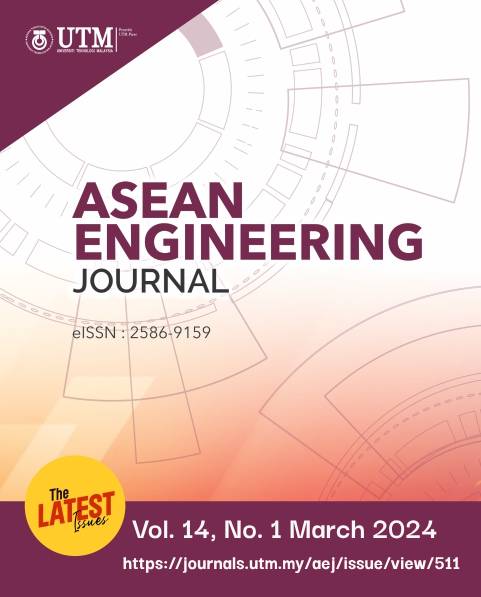INTERFACE SHEAR STRENGTH DEGRADATION IN PROGRESSIVE LANDSLIDE OF WEATHERED CLAY SHALE OVERBURDEN ON UNDISTURBED CLAY SHALE
DOI:
https://doi.org/10.11113/aej.v14.18154Keywords:
Clay shale, Direct shear test, interface shear strength, landslide, water infiltration, Clay Shale, Direct Shear Test, Interface Shear Strength, Landslide, Water InfiltrationAbstract
In accomplishing Sustainable Development Goals (SDGs), the construction of roads played a substantial role in achieving economic equity. However, landslides due to problematic soil would hinder its construction process. Thus, it is essential to understand the mechanism of slope movement to reduce landslide problems. A landslide that happened during the construction of the Semarang-Bawen toll road was analyzed in this research. The landslide was known to fail between the interface of the tuff breccia overburden and the problematic clay shale soil. This research proposed the direct shear test to determine the interface shearing behavior. Before the test, the overburden was differentiated as various sand and weathered clay shale ratios. After the overburden soils were compacted, a multistage interface direct shear test was conducted with three different loadings. Water was added to the overburden layer to model the infiltration at the interface by increasing the water content. From the test, results such as the interface cohesion, friction angle, and average stress ratio were obtained. Overall, the interface shear strength decreased as the water content increased. The decreasing value was due to the wetting at the interface. Thus, it would moisten the interface and disrupt the structure of both the top and bottom layers of the sample. In conclusion, the interface direct shear test was able to describe the shear behavior at the clay shale interface. It also indicated that water had a considerable role in triggering interface landslides for two different soil layers.
References
Cook, J. R., Huizenga, C., Petts, R., Sampson, L. R., Visser, C., & Yiu, A. 2017. Rural Transport Research in Support of Sustainable Development Goals. Transport and Communications Bulletin for Asia and the Pacific. 87.
Gunawan, Ade & Pratama, Yoga. 2020. Studi Analisis Penanganan Longsor pada Slope Timbunan yang Tegak (Studi Kasus Longsoran di Jalan Tol Ruas Semarang-BAwen KM 426+600) (in Indonesian). Jurnal Engineering Indonesia. 1(2): 16-22
Khrisna, R. H., Atmanto, I. D. & Wibowo, H. Evaluasi Stabilitas Lereng yang Telah Diperkuat pada Jalan Tol Semarang- Solo Seksi V Ungaran – Bawen (in Indonesian). Jurnal Karya Teknik Sipil. 2(4): 343-352.
Alatas, I. M. 2017. Kesan Luluhawa terhadap Kekuatan Ricih Syal Lempung dalam Penentuan Parameter Kestabilan Cerun (in Malaysian). PhD Thesis. Universiti Teknologi Malaysia.
Retno, S. P., Wardani & Muhrozi. 2011. Problem of High Embankment on Clay Shale at Semarang-Ungaran Toll Road STA 5 + 500 to 6 + 300. Proceedings of 3rd International Conference on Geotechnical Engineering for Disaster Mitigation and Rehabilitation 2011. 159 – 171.
Thades, R. E, Sumadirja, H., & Richards, P. W. 1975. Geologic Map of the Magelang and Semarang Quadangels, Java. 1:100,000. Geological Survey of Indonesia, Ministry of Mines. Indonesia.
Seedsman, R. W. 1993. Characterizing Clay Shales. Pergamon, Oxford, United Kingdom. https://doi.org/10.1016/B978-0-08-042066-0.50014-8
Oktaviani, R., Rahardjo, P. P., & Sadisun, I. A. 2018. Landslides Induced by Slaking of Geomaterial. Proceedings of International Conference on Disaster Management (ICDM) 2018. 229. https://doi.org/10.1051/matecconf/201822903011
Sadisun, I. A., Bandono, Shimada, H., Ichinose, M., & Matsui, K. 2003. Slope Instability of Road Cuts Due to Rock Slaking. Proceedings of 12th Asian Regional Conference on Soil Mechanics and Geotechnical Engineering. 747-750. https://doi.org/10.13140/2.1.2418.4963
Sadisun, I. A., Shimada, H., Ichinose, M., & Matsui, K. 2005. Study on the Physical Disintegration Characteristics of Subang Claystone Subjected to a Modified Slaking Index Test. Geotechnical and Geological Engineering. 23:199-218. https://doi.org/10.1007/s10706-003-6112-6
Alatas, I. M., Kamaruddin, S. A., Nazir, R., & Irsyam, M. 2016. Effect of Weathering on Disintegration and Shear Strength Reduction of Clay Shale. Jurnal Teknologi. 7-73(78): 93-99. https://doi.org/10.11113/jt.v78.9491
Li, Y.-K., Han, X.-L., Ji, J., Fu, D.-L., Qiu, Y.-K., Dai, B.-C., & Lin, C. 2015. Behavior of Interfaces between Granular Soil and Structure: A State-of-the-art Review. The Open Civil Engineering Journal. 9: 213-223. https://doi.org/10.2174/1874149501509010213
Zhang, G., Jianmin, Z. 2009. State of the art: Mechanical Behavior of Soil-Structure Interface. Progress in Natural Science. 19: 1187-1196.
https://doi.org/10.1016/j.pnsc.2008.09.012
Sagitaningrum, F. H., Kamaruddin, S. A., Nazir, R., Soepandji, B. S., & Alatas, I. M. 2020. Soil-solid interface shear strength review and its possibility on interlayer slope stability analysis. Proceedings of the 3rd International Conference on Eco-Engineering Development. 426. https://doi.org/10.1088/1755-1315/426/1/012062
Suzuki, M., Hai, N. V., & Yamamoto, T. 2017. Ring Shear Characteristics of Discontinuous Plane. Soils and Foundations. 57: 11-22.
https://doi.org/10.1016/j.sandf.2017.01.001
Frikha, W. & Jellali, B. 2018. Numerical and Experimental Studies of Sand-Clay Interface. Proceedings of The Ground Improvement and Earth Structure. 108-190. https://doi.org/10.1007/978-3-319-63889-8_9
Shakir, R. R. & Zhu, J. 2009. Behavior of Compacted Clay-Concrete Interface. Front Architecture Civil Engineering China. 3(1): 85-92. https://doi.org/10.1007/s11709-009-0013-6
Shakir, R. R. & Zhu, J. 2009. Mechanical Behavior of Soil and Concrete Interfaces. Proceedings of ICEM 2008: International Conference on Experimental Mechanics 2008. 73756R1-73756R8. https://doi.org/ 10.1117/12.839390
Pellet, F. L. & Keshavarz, M. 2014. Shear Behavior of the Interface Between Drilling Equipments and Shale Rocks. Journal of Petroleum Exploration and Production Technology. 4: 245-255. https://doi.org/10.1007/s13202-014-0108-z
Sadisun, I. A., Shimada, H., & Matsui, K. 2000. Characterization of Weathered Claystone and Their Engineering Significance. Proceedings of Indonesian Scientific Meeting 2000. 1-8. https:/doi.org/10.13140/2.1.2447.1685
Chung, S. H. 2019. Study of the Rainfall Infiltration Effect and Soil Strength Variation on Unsaturated Laterite Terraces. Proceedings of the 4th World Congress on Civil, Structural, and Environmental Engineering. ICGRE 1841-1848. https://doi.org/10.11159/icgre19.184
Skempton, A. W. 1985. Residual Strength of Clays in Landslides, Folded Strata, and the Laboratory. Geotechnique. 38(1): 3-19.https://doi.org/10.1680/geot.1985.35.1.3
Stark, T. D. & Hussain, M. 2010. Drained Residual Strength for Landslides. Proceedings of Geoflorida 2010: Advances in Analysis, Modeling, and Design. https://doi.org/10.1061/41095(365)328
Alatas, I.M. 2020. Perilaku Kekuatan Geser Interface antara Batuan Andesit dengan Variasi Material Timbunan Akibat Interusi Air (in Indonesian). Proceedings of Pertemuan Ilmiah Tahunan Himpunan Ahli Teknik Tanah Indonesia XXIV.
















